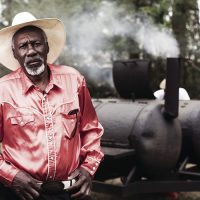John Campbell was a bundle of contradictions. He wore cowboy boots and snap-button shirts, but played the blues. Campbell could darken the brightest day with this remarkable scowl, something deepened by criss-crossing scars across his face, yet would laugh uproariously through a friendly game of cards. He listened intently to Lightnin’ Hopkins, but befriended Hell’s Angels.
Still, one thing is certain: When he died 15 years ago of a heart attack at just 41, the lingering result of a drag-racing accident two decades before that literally crushed him, the Shreveport native had overcome much — and accomplished much — over a startlingly short period. Few in his genre did more to confront the traditional, time-soaked blues idiom and bring it kicking and screaming into modernity.
John Campbell’s sound incorporated the tempo of Muddy Waters and lusty appetites (the basso profundo vocals, too) of John Lee Hooker, but also the impishness of Chuck Berry and the soaring creativity of the Allman Brothers. (He copped to his Southern roots, as well, by playing old-school guitars like the 1952 Gibson Southern Jumbo acoustic, a 1934 National Steel and a 1940s National resophonic guitar.)
Campbell later opened shows as a teen for blues greats like Clarence “Gatemouth” Brown and Albert Collins, and also ingested their complex innovations into his music. Finally, Campbell had overcome a staggering addiction, something all the more ironic considering how his body ultimately failed him — just as he was gaining (and this seems like a blues song, too) national acclaim.
You might have guessed his fate, listening to Campbell’s music. Much of it was shot through with a deep and dark foreboding, something more ruminative than your average these-days blues — more in keeping with the long-ago doomed genius, say, of Robert Johnson: “I got the Devil in my closet,” Campbell sang on his Elektra debut, “and the wolf is at the door.” Spiritual and demanding, his recordings aren’t run-of-the-mill listening, even now.
Yet, in person, John Campbell was something else entirely — generous and soft-spoken. He belied the scary sound of his slide-driven music, and his own sometimes dour looks. (That accident had had taken his right eye, and left Campbell with several broken ribs and a collapsed lung. His face had to be reconstructed, a procedure that required nearly 5,000 stitches.) “I have worked for this and prayed for this,” he said, when the ink on the Elektra deal was still wet. “So, every day I feel blessed to have the opportunity to go out and do it.”
In the end, his was a short, stormy, and now storied career. Campbell’s first album, A Man and His Blues recorded for a German label with Ronnie Earl and Jerry Portnoy, was nominated for the prestigious W.C. Handy Award (the genre’s Grammy) for best traditional blues artist. Rolling Stone called One Believer, that initial record on Elektra, “a hauntingly beautiful album of truly modern blues.” (Emphasis theirs.)
All the while, Campbell rarely slept, he said – fearful that he would not awake. For all his modernity, there hung about him a timeless portent, illustrated in the title track:
When the trees stand naked and it’s almost dark
One man walks slowly, alone in the park
His mind is full of visions only he can see
And Lord, Lord, Lord, he looks a lot like me
Campbell seemed on the cusp of something bigger, both personally and professionally, when he died in June 1993. Howlin’ Mercy, the follow up on Elektra, pushed the envelope in a music that seemed caught up in old heads and yesteryear. An album issued in early 2000 subsequently explored some of Campbell’s acoustic influences. Recorded prior to his Elektra contract, Tyler Texas Sessions included blues standards by Waters and Elmore James, among others. You get a clearer idea about where he came from, but there was always more to the mythical place where he was going.
John Campbell wasn’t about settling for the past, so much as creating an elixir based on then and now: “There is a lot of magic in music,” he once said, “and there are a lot of elements of that in my music.” Then, just like that, it all turned to ashes. Campbell’s body was cremated, along with personal items and a number of family talismans (in keeping with the Louisiana voodoo mythology that had already billowed up around him). He was eulogized in a ceremony led by by Dr. John before a procession of biker friends took his remains home.
- How Deep Cuts on ‘Music From Big Pink’ Underscore the Band’s Triumph - July 31, 2023
- How ‘Islands’ Signaled the Sad End of the Band’s Five-Man Edition - March 15, 2022
- The Band’s ‘Christmas Must Be Tonight’ Remains an Unjustly Overlooked Holiday Classic - December 25, 2016



